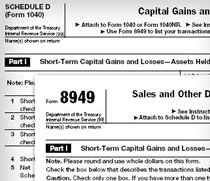 Tax-loss harvesting (TLH) is a technique used to minimize taxes on your taxable investments by “harvesting” capital losses during market declines. With DIY investors, losses are usually only harvested once a year. But with an computer as your portfolio manager, you could attempt to harvest losses continually on a monthly or even daily basis.
Tax-loss harvesting (TLH) is a technique used to minimize taxes on your taxable investments by “harvesting” capital losses during market declines. With DIY investors, losses are usually only harvested once a year. But with an computer as your portfolio manager, you could attempt to harvest losses continually on a monthly or even daily basis.
Wealthfront, Betterment, and FutureAdvisor all tout the benefits of their automated tax-loss harvesting services, each claiming that their service could increase your returns somewhere between 1% and 3% a year on average. Those are impressive numbers, and most importantly a much bigger number than the fees they charge. Great deal?
Elisabeth Kashner of ETF.com takes a closer look at those claims. Here is my summary of the noted concerns:
- Tax-loss harvesting defers your taxes by lowering your cost basis. This means that you’ll have to pay more taxes later when you eventually sell (unless you die or donate it). Data presented by certain robo-advisors do not take this into account, and continue to avoid the subject even when confronted about it directly.
- Most of the claims rely on theoretical backtested data, not the results of actual client portfolios. This is somewhat understandable as many of them are new, but we find that when real-world results are being published, those excess return numbers have so far been under 1% annualized.
- More than one of them cherry-picked the period from 2000 to 2013 for their analysis, which has the ideal sequence of returns – big losses first (so you can harvest something) and then big gains afterward (so you can compound your tax-deferred money). If you choose other time periods the numbers can come out significantly less rosy.
- Most of the analyses assume that the investor is in the highest tax bracket (35% or higher), which maximizes the tax benefit. However, many investors in these services could be in the 15% income tax bracket or even 0% capital gains tax bracket. That will also lower the actual tax benefit of TLH.
Read the article comments as well. There, finance author Rick Ferri adds:
I agree the benefit of TLH isn’t 1%, but it isn’t 0.09% either. The answer is someplace in the middle – and it is investor specific.
I think this quote from the author sums things up well:
My point was not that there is never any value to TLH. It’s that predicting this value is fraught, because there are many variables. Given this variability, I find it questionable that the robo advisors’s marketing materials present best-case scenarios, sometimes without accounting for the terminal capital gains liability caused by the lowered basis.
Essentially, temper your expectations as the numbers being marketed at you are based on best-case scenarios. It is impossible to know the true benefit of tax-loss harvesting ahead of time, but quite possibly less than 1% annualized. This still leaves the possibility for the benefits of automated TLH to outweigh the cost, but it is nowhere near a certainty.
 The Best Credit Card Bonus Offers – 2025
The Best Credit Card Bonus Offers – 2025 Big List of Free Stocks from Brokerage Apps
Big List of Free Stocks from Brokerage Apps Best Interest Rates on Cash - 2025
Best Interest Rates on Cash - 2025 Free Credit Scores x 3 + Free Credit Monitoring
Free Credit Scores x 3 + Free Credit Monitoring Best No Fee 0% APR Balance Transfer Offers
Best No Fee 0% APR Balance Transfer Offers Little-Known Cellular Data Plans That Can Save Big Money
Little-Known Cellular Data Plans That Can Save Big Money How To Haggle Your Cable or Direct TV Bill
How To Haggle Your Cable or Direct TV Bill Big List of Free Consumer Data Reports (Credit, Rent, Work)
Big List of Free Consumer Data Reports (Credit, Rent, Work)
Excellent post. This is why I come here…
Good summary of the key concerns. It would be interesting to see them run backtested results from the bull markets of the 80s and 90s. My guess is the benefits would have been minimal. Instead they chose a stretch that included two massive market corrections. I’d also be interested to see what percentage of assets the average retail investor has in retirement accounts vs. taxable. I suspect many have most (if not all) in 401(k) plans or IRAs.